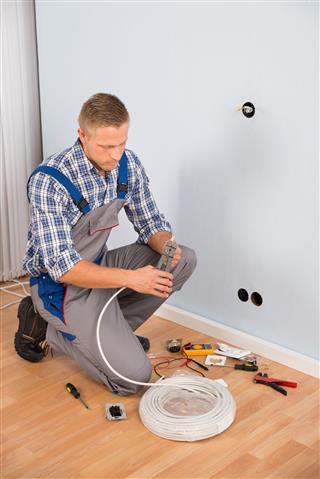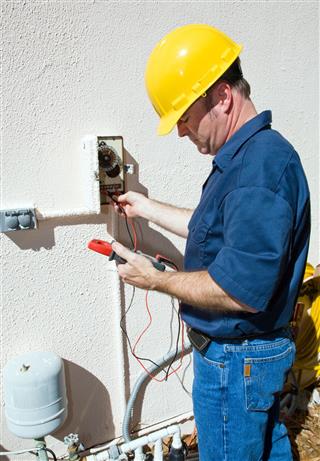
The American Wire Gauge (AWG) has provided guidelines on different wire diameters that are to be used according to the type of wire. For more details, scroll down…
For safe and optimum use of gadgets and appliances at home as well as offices, it is very important to have the correct type and size of wires used. There are various factors that are to be taken into consideration for this purpose, and that is what we will have a look at in the coming paragraphs.
Wire Size Calculator
The American Wire Gauge (AWG) system adopted in 1857 has defined a method for electrical wire size calculator. The method has two basic objectives, that is, the ratio of the largest size with the smallest size would be an integer. The second goal, the resulting gauges would generally correspond to the proprietary gauges used at the time.
The size of gauges larger than 0 gauge are calculated for example, 1 is 89% of gauge 0, then gauge 0 will be 89% of gauge 00, that will be 89% of gauge 000 and so forth. The AWG standard defines 0000 gauge wire as 0.46 inches and 36 gauge as 0.005 inches.
The formula for the AWG wire sizes. The formula is as follows:
Formula #1
Dn = (D0) r( (N – (d + n) ) ÷ N)
Where,
Dn = Diameter of ‘n’ gauge wire
r = Ratio between the largest and the smallest wire
N = Number of draws needed to obtain the smallest wire from the I
d = Offset of the largest gauge from 0.
In order to calculate the wire size, substitute the values in the formula as follows:
The standards used are, D0 = 0 ÷ 005, r = 0.46 ÷ 0.005 = 92 and d = -3.
Therefore, the formula is now:
Dn = 0.005 in. × 92( ( 36 – n) ÷ 39)
Dn = 0.127 mm × 92( ( 36 – n) ÷ 39)
The gauge is calculated using log:
n = -39 log92 (Dn ÷ 0.005 inch) + 36 = -39log92 (Dn ÷ 0.127 mm) + 36.
Universal Wire Sizing Chart
Apart from the above formula, you can use the following steps for any voltage or voltage drop. It can also be used for American (AWG) or metric (mm 2) sizing. This calculation is applied to typical DC circuits and a few simple AC circuits. These AC circuits are single-phase with resistive loads and not motor loads. Their power factor is 1.0 with a negligible line reactance.
Formula #2
VDI = (AMPS × FEET) ÷ (% VOLT DROP × VOLTAGE)
Here,
VDI= VDI = Voltage Drop Index (the reference number that is based on resistance of wire)
FEET = ONE-WAY wiring distance (1 meter = 3.28 feet)
% VOLT DROP = Voltage drop that is acceptable according to your choice (example: use 2 for 2%)
In order to determine the correct wire size to be used, you can compare your calculated VDI with the VDI mentioned in the chart below. This will help you determine the closest wire size you can use. Remember, amps should never exceed the Ampacity mentioned for a particular wire size.
| Wire Size | Area mm2 | COPPER | |
| AWG | VDI | Ampacity | |
| 0000 | 107 | 99 | 260 |
| 000 | 85.0 | 78 | 225 |
| 00 | 67.4 | 62 | 195 |
| 0 | 53.5 | 49 | 170 |
| 2 | 33.6 | 31 | 130 |
| 4 | 21.1 | 20 | 95 |
| 6 | 13.3 | 12 | 75 |
| 8 | 8.37 | 8 | 55 |
| 10 | 5.26 | 5 | 30 |
| 12 | 3.31 | 3 | 20 |
| 14 | 2.08 | 2 | 15 |
| 16 | 1.31 | 1 | 10 |
For Example:
10 Amp load at 22V for a distance of 50 feet with 2% max. drop voltage drop.
So according to the formula:
VDI= (10 × 50)/2 × 22) = 500 ÷ 44 = 11.36
Thus, for the copper wire, according to the table the nearest VDI is 12. Thus, you need a #6 AWG wire.
Table of Wire Size Requirements
You need to follow a wire chart table that will serve as a guideline of ampacity or copper wire current carrying capacity. You should follow the Handbook of Electronic Tables and Formulas for American Wire Gauge to refer to electronic wire sizing chart. One needs to consider the voltage drop, insulation temperature limit, thickness, thermal conductivity, air convection and temperature. You should consult the expert that is your local electrician and find out what is required and legal in your area.
According to the AWG, gauge indicates the diameter of the wire. These wires include aluminum, copper as well as other wire material. You should remember that higher the gauge, the diameter of the wire is smaller and is thinner in appearance. The following table will help you with the conversion of the wire size in square mm cross-sectional area for a copper wire. It will also help you understand the above formula no. 1 easily.
| American Wire Gauge (AWG) |
Diameter (inches) |
Diameter (mm) |
Cross Sectional Area (mm2) |
| 0000 | 0.46 | 11.68 | 107.16 |
| 000 | 0.4096 | 10.40 | 84.97 |
| 00 | 0.3648 | 9.27 | 67.40 |
| 0 | 0.3249 | 8.25 | 53.46 |
| 1 | 0.2893 | 7.35 | 42.39 |
| 2 | 0.2576 | 6.54 | 33.61 |
| 3 | 0.2294 | 5.83 | 26.65 |
| 4 | 0.2043 | 5.19 | 21.14 |
| 5 | 0.1819 | 4.62 | 16.76 |
| 6 | 0.162 | 4.11 | 13.29 |
| 7 | 0.1443 | 3.67 | 10.55 |
| 8 | 0.1285 | 3.26 | 8.36 |
| 9 | 0.1144 | 2.91 | 6.63 |
| 10 | 0.1019 | 2.59 | 5.26 |
| 11 | 0.0907 | 2.30 | 4.17 |
| 12 | 0.0808 | 2.05 | 3.31 |
| 13 | 0.072 | 1.83 | 2.63 |
| 14 | 0.0641 | 1.63 | 2.08 |
| 15 | 0.0571 | 1.45 | 1.65 |
| 16 | 0.0508 | 1.29 | 1.31 |
| 17 | 0.0453 | 1.15 | 1.04 |
| 18 | 0.0403 | 1.02 | 0.82 |
| 19 | 0.0359 | 0.91 | 0.65 |
| 20 | 0.032 | 0.81 | 0.52 |
| 21 | 0.0285 | 0.72 | 0.41 |
| 22 | 0.0254 | 0.65 | 0.33 |
| 23 | 0.0226 | 0.57 | 0.26 |
| 24 | 0.0201 | 0.51 | 0.20 |
| 25 | 0.0179 | 0.45 | 0.16 |
Importance of Wire Size
The primary consideration to be taken before wiring a new circuit is the wire size and wire type. The current ratings of the power loads is the factor that is to be considered when determining the wire size and wire specifications. If the current is fast and the wire size small, the wire will get heated up too soon. This melts the insulation around the wire that can lead to a dangerous situation. The continuous high temperature running through the wire causes corrosive effect at the terminal connections of the wire. This makes the stranded wire lose its strands one at a time and the solid wire to become brittle. The wire becomes smaller and there is increase in heat. Thus, this increase in current causes the wire to break off that may lead to a serious complication. The hanging live wire inside the control panel may get too hot causing the insulation to melt and lead to a fire hazard.
The information on wire specifications should be based on the insulation of the wire and its temperature ratings. The environment, temperature rating and the application of the wire should be considered when selecting the appropriate wire specification and wire type. The wire should be used according to the National Electrical Code (NEC) electrical wire specification. You should check whether the wire is rated for direct burial underground or not. Ask the local electrical inspector of your area for rules regarding wire specification for the type of wire and its application. Never try replacing the wires and outlets on your own, especially when you do not have any basic knowledge or experience regarding this job.
You should follow the guidelines stated in the AWG Handbook of Electronic Tables and Formulas and take advice from your local electrician. You must follow the wire chart when adding or changing new circuit for your home, office or workplace. You should take ample care regarding the wire specifications laid down by National Electrical Code (NEC). You should carefully follow electrical safety at home and your workplaces to avoid any unfortunate electrical mishap. This will help protect your property and many innocent lives from a possible fire hazard due to short-circuit.

